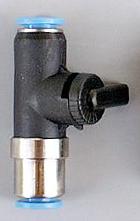 

A manual fuel shut-off valve
is required for safe
operations
  This valve should be
closed at all times except during normal engine operation. It is especially
important to close it prior to fueling the model. This valve should be
closed at all times except during normal engine operation. It is especially
important to close it prior to fueling the model.
 The manual shut-off valve should be located
such that it is easily reached and closed if a start sequence goes
awry. The manual shut-off valve should be located
such that it is easily reached and closed if a start sequence goes
awry.
 If you
suspect that the engine has excess fuel in it prior to a start, purge the
engine as necessary, then begin the next start sequence with the valve closed.
If all is going well during the start, open the valve slowly. If you
suspect that the engine has excess fuel in it prior to a start, purge the
engine as necessary, then begin the next start sequence with the valve closed.
If all is going well during the start, open the valve slowly.
 Make it a habit to close
the valve at the end of the engine shutdown procedure.
BVM #5315 Make it a habit to close
the valve at the end of the engine shutdown procedure.
BVM #5315
Fuel drain holes
for fire
prevention
 It is a good safety practice to drill a series
of 1/16" holes in the bottom of the fuse (or wings) wherever fuel spills or
leaks from fuel tanks might accumulate. It is a good safety practice to drill a series
of 1/16" holes in the bottom of the fuse (or wings) wherever fuel spills or
leaks from fuel tanks might accumulate.
 Additionally drill a few 1/16" holes in the bottom of the
engine bypass duct. A wet spot under your model may alert you to a leaking tank
or an overfill condition. More importantly, eliminating any puddling of fuel in
the model will reduce the risk of a serious fire during a bungled
start-up. Additionally drill a few 1/16" holes in the bottom of the
engine bypass duct. A wet spot under your model may alert you to a leaking tank
or an overfill condition. More importantly, eliminating any puddling of fuel in
the model will reduce the risk of a serious fire during a bungled
start-up.
Contact Us
All graphics, photos, and text
Copyright 2011 BVM, Inc.
Use of graphics or photos without written permission from
BVM is
strictly prohibited.
|